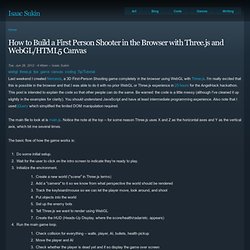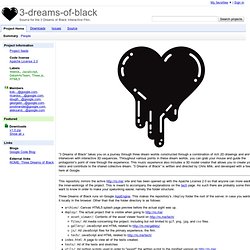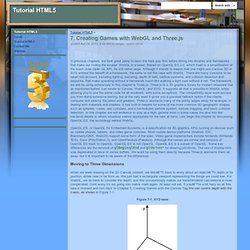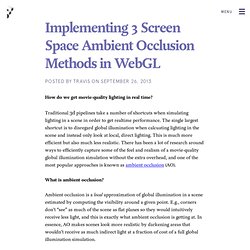

Game Engines. Game Engines · bebraw/jswiki Wiki. WebGL. WebGL Libraries. ThreeJS. Introduction to Three.js. Ilmari Heikkinen Who am I? Ilmari Heikkinen @ilmarihei | fhtr.org/plus | fhtr.org Google Chrome Developer Programs Engineer I write demos, do presentations, write articles Slides available at fhtr.org/BasicsOfThreeJS Repo at github.com/kig/BasicsOfThreeJS. How to Build a First Person Shooter in the Browser with Three.js and WebGL/HTML5 Canvas. Last weekend I created Nemesis, a 3D First-Person Shooting game completely in the browser using WebGL with Three.js.

I'm really excited that this is possible in the browser and that I was able to do it with no prior WebGL or Three.js experience in 23 hours for the AngelHack hackathon. This post is intended to explain the code so that other people can do the same. Be warned: the code is a little messy (although I've cleaned it up slightly in the examples for clarity). IceCreamYou/Nemesis. 3-dreams-of-black - Source for the 3 Dreams of Black Interactive Film. “3 Dreams of Black” takes you on a journey through three dream worlds constructed through a combination of rich 2D drawings and animations interwoven with interactive 3D sequences.

Throughout various points in these dream worlds, you can grab your mouse and guide the protagonist’s point of view through the experience. This music experience also includes a 3D model creator that allows you to create your own relics and contribute to the shared collective dream. “3 Dreams of Black” is written and directed by Chris Milk, and developed with a few folks here at Google. This repository mirrors the active site and has been opened up with the Apache License 2.0 so that anyone can more easily look at the inner-workings of the project. This is meant to accompany the explanations on the tech page. As such there are probably some things you'll want to know in order to make your spelunking easier, namely the folder structure: Three Dreams of Black runs on Google AppEngine.
FPS0. A minimal First Person Scenery with a Blender level and dynamic content The goal of this project was to explore the options for a simple game with first person controls that runs completely in a browser.

To achieve this I wanted to be able to load a 'level', i.e. a basic 3D model (in this case with Blender)create 'WASD' first person type of controlsapply simple physics with collision detection to walk around and interact with objectsadd dynamic objects on runtime Luckily, all of the ground work was already done by someone else. :-) Basically this demo merges the Blender scene loader of mrdoobs ThreeJS library and the CannonJS FPS example by schteppe. I added the idea that the imported Blender geometry gets turned into a static model in the physics engine by finding the cubes and adding invisible physical collision boxes to their position.
This worked surprisingly well and gives some sort of minimal FP(S) - completely running in the browser. Some information Here's the live example. Video. Voxel.js * blocks in yo browser. Introduction to Three.js. BabylonJS. WebGL Tutorials. LearningWebGL Websites. Learning WebGL (learningwebgl) sur Twitter. Webgl Academy : tutorial to learn WebGL. Learning WebGL. A year ago, at a biggest-ever, record-breaking HTML5 Meetup in San Francisco all about WebGL, I predicted we were a tipping point; I think I was right.

Let’s take a look at 2014, a banner year for 3D on the web! A Year of Great Content John Cale and Liam Young’s City of Drones brought together experiments in music and architecture; Isaac Cohen continued to blow minds with visualizations like Weird Kids and Webby; Google’s A Spacecraft for All chronicled the 36-year journey of the ISEE-3 space probe; and SKAZKA showed us an alternate world created by The Mill and powered by Goo. 51c7048eec8aa_1371996880409. 7. Creating Games with WebGL and Three.js - Tutorial HTML5. In previous chapters, we took great pains to learn the hard way first before diving into libraries and frameworks that make our coding life simpler.

WebGL is a beast. Based on OpenGL ES 2.0, which itself is a simplification of the much older Open GL API, its still rather large. Although it stands to reason that one might use Canvas 2D or SVG without the benefit of a framework, the same is not the case with WebGL. There are many concerns to be taken into account, including lighting, texturing, depth of field, particle systems, and collision detection and response, that make operating without a framework much like walking a tight rope without a net.
The framework we will be using extensively in this chapter is Three.js. OpenGL ES, or OpenGL for Embedded Systems, is a specification for 3D graphics APIs running on devices such as mobile phones, tablets, and video game consoles. Moving to Three Dimensions Figure 7-1. New THREE.Vertex(new Vector3(0, 0, 0)); Learning WebGL Books. AgendaEurope1 - WebGL Camp. WebGL Programming Guide. WebGL Beginner's Guide. Proffesional WebGL Programming. People. Learning WebGL (learningwebgl)
Blogs. All things web3d, 3d internet and virtual worlds – by Dirk Krause. Dirk Krause (dirkk) sur Twitter. Dirkk0 (Dirk Krause) Badass JavaScript. Implementing 3 Screen Space Ambient Occlusion Methods in WebGL. How do we get movie-quality lighting in real time?

Traditional 3D pipelines take a number of shortcuts when simulating lighting in a scene in order to get realtime performance. The single largest shortcut is to disregard global illumination when calcuating lighting in the scene and instead only look at local, direct lighting. This is much more efficient but also much less realistic. There has been a lot of research around ways to efficiently capture some of the feel and realism of a movie-quality global illumination simulation without the extra overhead, and one of the most popular approaches is known as ambient occlusion (AO). NYC WebGL Developers (New York, NY.
Dissecting WebGL on Livestream.